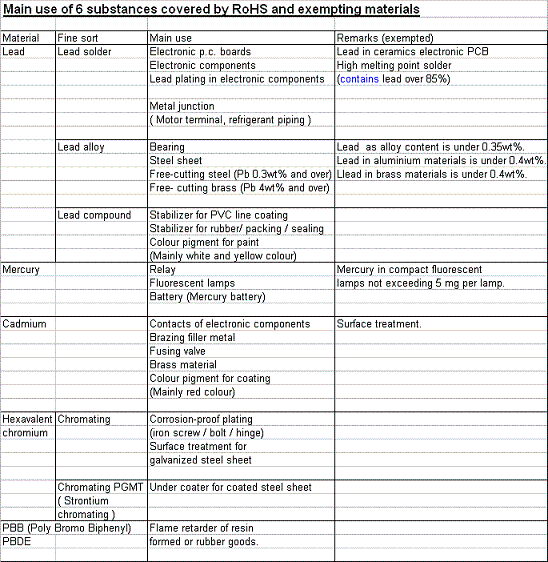ROHS Directive
ROHS Directive is a single market Directive on the restriction of certain hazardous substances. It seeks to reduce the environmental by restricting the use of certain hazardous substances during the manufacturing of electrical and electronics products. It is complementary to the WEEE Directive. It cover all products that are covered by the WEEE Directive except categories 8 & 9.
Effective from 1 July 2006, the following 6 substances had been banned.
1) LEAD
2) MERCURY
3) CADMIUM
4) HEXAVALENT CHROMIUM
5) POLYBROMINATED BIPHENYLS(PBB)
6) POLYBROMINATED DIPHENYL ETHERS (PBDE)
The Directive is having a major impact on the design of electrical and electronic products as industry invests in finding alternatives to key substances such as lead and brominated flame retardants.
There is continuing debate on the environmental impact of the banned substances, along with pressure for more exemptions.
Lead is a substance of concern around the world. A high percentage(may be up to 90%) of electronic components contain lead, mainly lead solder. Finding alternatives to lead solder is a massive undertaking because of product reliability, component compatibility, energy use, and cost issues.
Brominated flame retardants are also ubiquitous in electronic products and are used primarily in printed wiring boards, plastic housings, and cables. The Directive requires the elimination of two categories of retardant: polybrominated biphenyls (PBBs) and polybrominated diphenyl ethers (PBDEs).
Another brominated flame retardant — tetrabromobisphenol (TBBP-A), which is widely used in electronic equipment — may be added to the list in the future.Research continues on alternative flame retardants, such as those based on phosphorous, and on materials that are able to withstand such high temperatures that they do not require flame retardants. Environmental organizations are pressing for a ban on all brominated flame retardants.
Figure below shows some examples of the 6 substances and their exempting materials.

Impacts of the Directive
Europe is one of the largest markets in the world, and any company wishing to sell electrical and electronic equipment in this market will be able to do so only if it removes the hazardous substances specified in the Directive.
Japan now leads the world in eliminating hazardous substances from these products, and China has announced a policy modeled on RoHS.
Critical Directive Dates
February 13, 2003 --- RoHS Directive goes into effect.
August 13, 2004 --- Member states enact implementing legislation/regulations/administrative actions.
February 13, 2005 --- EU Commission reviews provisions of the directive, taking into account new scientific evidence;proposals to be submitted for adding to the list of banned substances.
July 1, 2006 --- Member states ensure that all electrical and electronic equipment put on the market containsno lead, mercury, cadmium, hexavalent chromium, or PBBs or PBDEs (brominated flame retardants).



New! Comments
Have your say about what you just read! Leave us a comment in the box below.